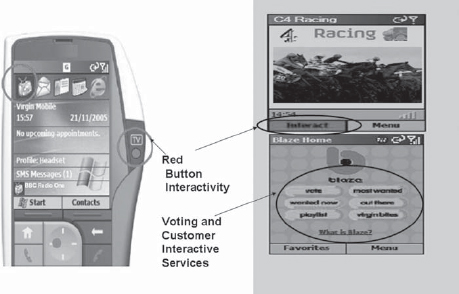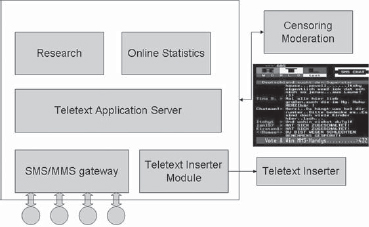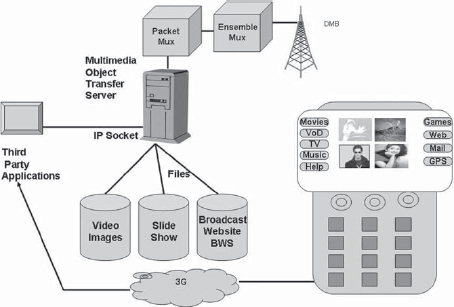INTERACTIVITY AND MOBILE TV
New ideas are one of the most overrated concepts of our time. Most of the important ideas that we live with aren’t new at all.
—Andrew A. Rooney, American journalist
16.1 INTRODUCTION: WHY INTERACTIVITY IN BROADCAST MOBILE TV?
The availability of broadcast TV on mobile phones opens a new era of opportunity. The handset is now an integration of the “DVB world” and the 3G mobile world. The digital video broadcasting functions bring with them rich functionalities of broadcast TV together with its interactive functions of electronic service guide and selection of information from the streamed data carousel. At the same time, the mobile functionalities add a new dimension to the interactive function by providing a return path and wideband data access for rich applications to be used at the same time as TV, such as ordering of music and videos, movies on demand, and advertised products and services. Synchronized applications such as voting, instant messaging, and MMS-based picture sharing (which may be broadcast) are other applications considered attractive.
However, interactivity is not about simply having a return path for users to respond with. Rather it goes deep into the design of interactive applications. The interactive part of the broadcast application turns the mobile phone into a device for instant voting, instant downloads, instant SMS and MMS with broadcast facility, and instant shopping or ordering. Effectively written applications bring these functions down to single-function keys that enable users to take an action (such as vote, send SMS, or download a clip that is running) by pressing a single button. Live TV broadcast on mobiles has insufficient clarity for the users to be able to read voting or solicitation messages. However, the interactive applications can provide menus that are clearly readable through simulcasting of the interactive content along with a normal broadcast TV channel carried on mobiles.
16.2 MAKING MOBILE TV INTERACTIVE
A mobile TV transmission (via any system such as DVB-H or DMB) comprises a video stream, audio stream, and auxiliary data stream in the form of a mini-data carousel. Interactive applications are provided by using the mini-data carousel (Fig. 16-1).

FIGURE 16-1 Making Mobile TV Interactive
For example, if DVB-H is carried as a multiplex so that around 3.5 Mbps are available, then the service can carry around 9 or 10 channels of 350 kbps each. One of these can be assigned to the IP data carousel so that the customers can get the interactive services. The reverse link uses the underlying 3G network. The carousel can be executed by using the object carousel transport system defined by MPEG-2 (ISO 13818-6) or by using the FLUTE protocol.
The DVB-H transmission format, which uses IP datacast, has a provision for the data carousel, which is delivered using the FLUTE file transfer application. FLUTE is a unidirectional protocol for delivering files (via data carousels).The data that can be transferred using FLUTE includes electronic service guide, HTML pages on pull basis, logos, pictures, video clips, etc. The data is always transmitted in an endless loop so that any receiver in on the network will have the needed file in a few seconds. Frequently used data such as “Now” and “Next” on the EPG is broadcast with a higher repetition rate for quick upload of the file.
As an example, when 3 Italia launched their DVB-H services in June 2006, they used an application called FastESG from Expway, France. FastESG is a DVB-CBMS-compliant electronic service guide server (ESG) that pushes its content using the FLUTE protocol to the mobile phone. The FastESG application is designed for the support of multiple features such as live TV, on-demand clips, ring tones, images, and games.
Some of these content types are unique to the mobile network and the availability on the ESG makes the shopping or viewing experience more entertaining and it thus generates higher ARPUs (Fig. 16-2).
The DVB-CBMS IP datacast protocol lays down the precise manner in which the data carousel can be used. Operators come up with practical and friendly user interfaces, which permit the users to select an item, e.g., headlines or weather, that may be being telecast using the DVB-CBMS data carousel.
16.2.1 T-DMB in Korea
In Korea the T-DMB is a broadcast network with which the users have a choice of a variety of backward channels, including GPRS, EDGE, UMTS, CDMA, and WiBro. In practice the most common phones use CDMA as the return path due to the dominance of the CDMA networks and these phones are available from LG and Samsung.
FIGURE 16-2 IPDC Protocol Stack in the DVB-H System
The T-DMB service uses MPEG-4 BIFS (binary format for scenes) as the core technology for transferring interactive data. It uses AV-independent MPEG-4 objects transfer technology. The T-DMB system does not use an IP layer like the DVB-H, hence file transfer technology such as FLUTE, which uses an underlying IP transport mechanism, is not used. Instead the MPEG-4 raw data streams are multiplexed onto the MPEG-2 transmit stream. The transmission layer is DAB (Eureka 147) stream mode, which provides a fixed bit rate availability to the transmitted data. In addition legacy DAB data services such as Broadcasting Web Site service (BWS), EPG, and Slide Show can be provided (Fig. 16-3).
The multimedia objects transfer (MOT) protocol is given by ETSI EN 301 234 versions 1.2.1 and 1.2.2 (multimedia objects transfer). Typically the MOT server application has an IP socket, which can interface with third-party applications. The MOT server prepares the carousels using the objects (video, images, audio) and slide shows (BIFS). The carousels are transmitted in a repetitive manner to enable the mobile phone application to receive and display the contents as per the MPEG-4 BIFS protocols.
FIGURE 16-3 Multimedia Objects Transfer in T-DMB
In the Korean T-DMB network the interactive and data services provided are:
• AV-synchronized interactive data service,
• traffic and travel information service,
• television mobile commerce, and
• electronic programming guide.
The data services provided include:
• BWS,
• Slide Show on DAB, and
• IP tunneling service.
A number of derived services are provided, such as interactive news, interactive drama, and interactive advertisements.
16.2.2 3G Networks
3G networks are by their very nature bidirectional networks. The 3G-UMTS networks can provide unicast (or multicast) TV sessions to mobile phones and in this case the functionality achieved is similar to that of DVB-H in terms of delivery of the video and audio. For example, a DVB-H network may provide live TV at 384 kbps and have reverse interconnectivity using the GSM layer. A similar type of connection would exist in a UMTS network with 400 kbps video streaming and a reverse connection via UMTS. However, the main difference comes in scaling up the networks. In the case of a broadcast network such as DVB-H, all users can download the images, logos, ring tones, etc., which may be placed on the data carousel. However, this is not the same for a 3G network, in which the information must be streamed by a unicast connection to each user individually. Broadcast networks such as MBMS are needed to have the same functionality that a broadcast network such as DVB-H provides.
Mobile TV services on 3G networks with interactive features are now widely available. For example, British Sky Broadcasting (BskyB) has made available its channels on mobile phones via a 3G operator (e.g., Vodafone). The mobile users get the same electronic service guide with same look and feel as BskyB. The service is available on Symbian handsets with a downloadable application called Skybymobile. The Skyby-mobile users can get scoreboards for sports events, magazines on various topics including celebrities, and movies and also place bets using their mobile phones.
A number of 3G networks have been using Gemstar’s TV Guide on Mobile application, which provides an interactive electronic service guide on the mobile phones. In Japan NTT DoCoMo and KDDI use Gemstar’s TV guide called G-Guide on their 3G networks.
16.2.3 Broadcast Networks and Interactivity
Interactivity in pay-TV broadcast networks is well established. The DVB has been working toward evolving the multimedia home platform (MHP) standard for interactivity and middleware as far as satellite and terrestrial pay-TV applications are concerned. A number of other middleware platforms are used, such as OpenTV and NDS Core. In this scenario, how does the interactivity for mobile TV relate to the large screen applications?
The main differences lie in the nature of the mobile phone itself, which is used as a device for receiving mobile TV transmissions. These differences can be summarized as:
1. Mobile TV broadcasts have limited bandwidth to spare for carousel transmissions. Hence it is typical to support the ESG and one or two additional applications that are in the nature of magazines on news, weather, etc.
2. Mobile TV screens are tiny and it is not practical to have text tickers or text superimposed on video, multiple windows, or mosaic-type applications.
3. Mobile phones have the capability to process SVG-T, Java scripts, or Flash applications. Hence it is much more efficient to provide applications for interactivity written in these languages as they are small in size and provide appealing visual presentations.
4. Most mobile TV handsets can store significant amounts of data. Hence it is possible to have interactive data stored in the memory, such as SDK or MMC cards, for immediate use. It is also possible to have push VoD-type applications supported in this manner.
5. Middleware clients adapted for mobile environments are emerging with a view to provide a converged environment for standard TV and mobile TV broadcasting.
16.3.1 Simulcasting
BT Movio has launched the first DAB-IP service, which has been made available through its partner Virgin Mobile. The service, apart from the radio channels broadcast on the DAB, contains four TV channels, which are transmitted using the DAB-IP. The handsets have “red button interactivity,” which takes them to the Web sites associated with the programs being telecast. In this case such content for interactivity (e.g., broadcast Web sites) is simulcast with the live TV channels on the mobile. In the case of Virgin Mobile the handset used is the Virgin Mobile Lobster 700 TV (a Windows Mobile 5.0 handset) (Fig. 16-4).
The use of technologies such as simulcast needs cross-platform content development strategies to deliver content to digital TV, mobile TV, and IPTV platforms while maintaining distinctive interactivity features characteristic of each platform.

FIGURE 16-4 BT Movio DAB-IP Mobile TV Service (Picture Courtesy of BT)
16.3.2 MMS
SMS and voting are today extensively being used in broadcast programming as they have the potential to generate the highest revenues. Experience from popular music shows and contests has shown that using MMS with the picture of the participant (for example) displayed on screen creates a higher degree of personalization than what can be achieved by using merely SMS messages. Such MMS messages can be premium MMS messages. An example is the MMS to TV by conVISUAL, which provides services such as MMS2TV. Interactive TV is different from normal broadcast TV (where MMS and SMS may also be solicited). Normal broadcast TV when seen on mobile screens has virtually unreadable characters for any messages or SMS solicitations. Interactive TV, however, places its own menus overlaying the broadcast content and turns the mobile TV into a usable MMS interactivity device.
Voting is another service that comes quite naturally in any news, events, or “soaps.” The popularity of voting TV broadcasts demonstrates the desire of the audiences to interact. Voting in the conventional broadcast TV industry is somewhat of an obstacle as the mobile handset and the TV program are not correlated. Hence the user needs to be able to send a text message to indicate the TV channel, the program, and his vote. Many users do not bother to do it unless there are some incentives tied to sending messages. In an interactive TV environment the situation is quite different. Mobile TV programs with interactivity can have “single-button” SMS or MMS capability. The other relevant information, e.g., about the TV program, channel, and identity of user, is sent automatically, making it straightforward for the user to send messages. This method tends to develop much higher traffic and revenues.
16.3.3 Horse Racing and Betting
The United Kingdom’s Operator 3 has launched a streaming video service (“At the Races”), which allows the users to watch streaming live TV and also place bets while they watch the race. This is a niche product with which the users do not miss their favorite races nor the opportunity to place bets. The users use the video call function to dial the short video code (in this case 83415), which connects them to the streaming races being shown. Bets can be placed by pressing key “1” to connect to the call center.
16.3.4 Instant Downloads
Download of music and videos remains one of the main applications of mobile TV. However, these services have an impulse factor also associated with the purchase. The same is the case with tele-shopping programs. In such cases interactive TV can provide a much superior alternative by providing a single button such as “Download Now.” The users are then spared the trouble of typing out an SMS message and noting down the number to which it is to be sent. The DRM systems can take care of the usage rights of downloaded content and hence such processes can be operator transparent to a large extent.
It is much easier for users to purchase a sports T-shirt that may be displayed on a sports show or a garment being shown in a fashion show at the very time it is being shown, if the applications would permit it. Interactive applications enable such functionalities rather than making the users remember the item code and order it later.
16.3.6 Teletext Chat
Teletext Chat has proved to be a very popular application, as the users can see their messages appear on the screen typically within a minute. Usually the carriers charge for such messages as premium SMS. Teletext has the advantage that the chat occupies the various pages of Teletext and the main program is not burdened with such messages. Teletext has facilities for a number of pages and this helps creation of various chat rooms.
An example is Teletext Chats operated by MINICK in a number of European countries, including the United Kingdom, Germany, Switzerland, Spain, etc. The application is operated by a Teletext Chat application server, which is connected to various mobile networks through SMS/MMS gateways. A call center provides censoring and moderation services after which the messages are inserted into the Teletext stream using a Teletext inserter (Fig. 16-5).

FIGURE 16-5 Teletext Chat (Courtesy of MINICK)
16.4 PLATFORMS FOR PROVIDING INTERACTIVE MOBILE TV APPLICATIONS
A number of platforms have emerged to provide interactive applications that can be used in a stand-alone manner or be simulcast with the existing TV channels to make them interactive. An example is the Alcatel Mobile DTV platform.
Another approach is to extend those TV channels that are already running on interactive platforms (such as OpenTV) to the mobile world by bridging the mobile TV and the pay-TV worlds.
weComm, an interactive mobile TV company, and OpenTV have jointly brought forth a platform through which applications designed for broadcast pay TV using OpenTV (such as electronic service guides and other interactive applications) will be extended to mobile phones.
16.5 EXAMPLE OF INTERACTIVE END-TO-END APPLICATIONS AND NETWORKS: THE NORWEGIAN BROADCASTING CORP. TRIAL
The Norwegian Broadcasting Corp. trial is interesting as it was the first trial of interactive live TV in Europe. No less interesting was the conclusion that the users strongly preferred interactive live TV offering. The trial involved the use of the youth music program “Svisj.” The users can download a program on their mobile phones that allows them to interact with the program leaders or vote via watching the shows. Voting applications via SMS have been very popular and revenue-generating, but the interactivity achieved by the touch of a button while watching the program took it to a higher level and presented a potential model for future interactive applications.
Providing interactive services along with live mobile TV or rich multimedia content is the key to the generation of higher revenues. Broadcasters, mobile operators, and content providers are coming together to configure and operate platforms for broadcast and multimedia interactivity. Providing interactive programming can be quite different from simply delivering a broadcast TV program with no intended viewer interaction. Even the standard TV programs have adopted synchronized advertising and SMS interactivity. Mobile platforms can take these to a much higher level as the users can interact or respond with just a single key ready at hand. Content platforms harnessing the power of interactivity are available and being increasingly deployed.


